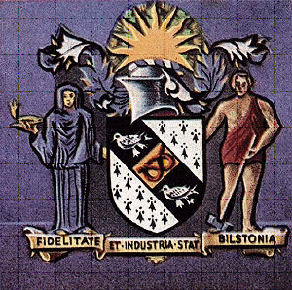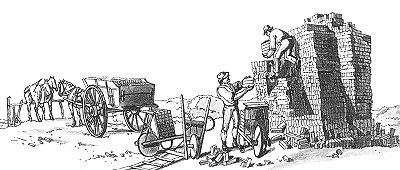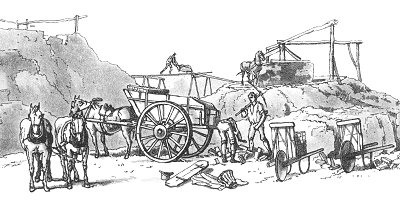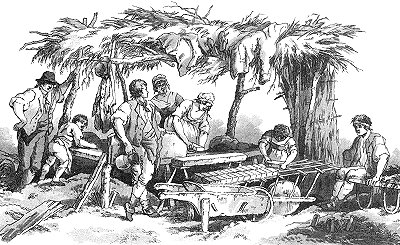 |
A History of Bilston4. Bilston in Transition 1790 |
|
It is interesting to note that agriculture still held its own, though industry was becoming more prominent. Till 1821, when the New Road was built, Wellington Street was covered with meadows and hedgerows. Not many years before this date, wheat was growing on the site of the later Market Hall. Oxford Street was enclosed fields and Cambridge Street was the site of a pleasant country farm.

Brick making. Bricks were always made as near the building site as possible. The Bilston area was well provided with good brick making clay and there were innumerable brick works, large and small, scattered around the area.
Lock making was carried on in Bilston at an early period - but was never very extensively engaged in. In 1590, there were three families of master locksmiths - the Perrys, the Kempsons, and the Tomkyses - but they employed few workmen. From 1590 to 1720 the trade seems to have been no further extended.
Japanning was carried on in Bilston in a small way as early as 1710. The first japanners worked upon materials and their first articles were made of wood and then lacquered and varnished. These consisted of small tea trays, wooden snuff boxes, snuffer stands, and the usual fancy articles, so familiarly known as Japanese goods. Wood was soon found to be unsuitable and a softer material, papier-mache, was invented in 1773. This was a few years afterwards almost discarded for thin sheet iron.

In the middle of the 18th century the enamelling trade developed in Bilston and flourished for more than one hundred years. These exquisitely decorated small items made Bilston famous, and famous for something which contrasted so strongly with its heavy industries.
The population 1780 was something over 3,000. In forty years it was to reach over 12,000. As industry took the place of agriculture so the population increased.

Making bricks. Women were often employed as brick makers, even up to modern times. Note the hard work being undertaken by the men.
The end of the eighteenth century was the transition period between rural and industrial England. Here is what a traveller passing through Bilston in 1760 said of it:
"It is one of the largest villages in England, containing more than 1,000 houses. It is situate on a rising ground on the old Watling Street Road, from London to Holyhead, and the navigable canal (not long opened) from Birmingham to London. The Worcestershire and Staffordshire Canal also passes close by it, by which means it enjoys a constant and ready means of communication with the metropolis, the western parts and the numerous manufacturing towns between them. Some thirty coaches pass through here daily, and the London coach weekly. It is of ancient date, probably going back as far as Saxon times. The low many gabled, half-timbered, octagonal shaped houses of the Tudor age, are dotted about here and there, and inhabited by the gentry, and stand without any regard for regularity. The principle manufactures consist chiefly of Japanned goods, buckle-chapes, which are wrought to great perfection, iron screws, and recently erected iron furnaces and foundries, worked by the steam engines.
"I visited Mr. Wilkinson's works at Bradley, and was enabled by that gentleman�s permission to see for the first time the process of iron manufacture. It was a novel sight to see the huge machinery in motion, and I came away much gratified. The puddlers used sand bottoms in the furnaces, but Mr Wilkinson told me he was trying experiments to do away with sand which sometimes injured the iron very materially.
"The Chapel is a modern edifice, though built on the foundations of an ancient structure. It is covered with slate, has a square tower of brick, and contains six bells. There are likewise a dissenting chapel and charity school. The principle Inn is the Bull, and the population, recently much increased is 4,800".
This description of Bilston in 1790 gives the last picture before industry was really to come into its own. From this date onwards Bilston was to receive its title as a town in the "Black Country"